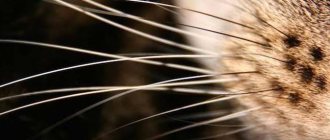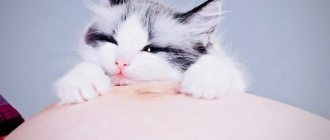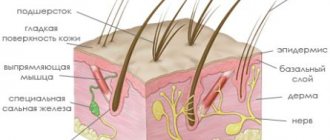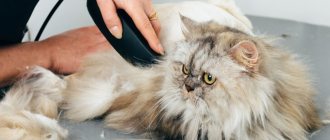Feeding cats fish - is it worth it?
Hello! Is it true that castrated cats should not be given fish? If so, why? Anna
Yes, Anna, it's true. Cats should not be given fish. And not only castrated. And not just cats.
Now angry objections will follow from owners of four-legged pets:
Objection one:
Cats eat fish all their lives! But not all of it!
It has been proven that the domestic cat descended from the African wild cat, which does not hunt fish. Cats themselves do not catch fish due to their fear of water. There are literally one or two breeds of real fishing cats, and you can count on one hand the number of domestic cats engaged in this fishing (of course, we do not mean cats sitting near an aquarium or by a small puddle). Fish are not natural prey for cats. Birds, mice and other small animals are her, the cat’s, native. And the man got the cat hooked on the fish. Thank you for watching! If you liked the video, share it with your friends:
Objection two:
Cats in villages constantly eat fish, and nothing! Yes, they do.
That's just nothing! Alas, the lifespan of many village murkas and vaseks is shorter than it could be. Of course, many factors influence its duration. And not the least role in this is played by the fish diet. Objection three: But I (or my uncle, friend, acquaintance, neighbor, etc.) had a cat that ate only fish and lived for 19 years! Well, it's possible. You (your uncle, friend, acquaintance, neighbor, etc.) are lucky, the cat turned out to have a strong body. But this is still an exception.
Objection four: What about industrial “fish” food for cats? More on this below.
Fifth objection: But “fish oil” is a source of essential Omega-3 fatty acids and other beneficial substances! This is true. And more about this below.
Why cats can't fish
Opponents of feeding rely on the following considerations:
- The product contains a lot of bones that can injure the cat.
- The product contains too much protein and minerals. If you use the product for a long time, this factor can actually have an adverse effect. But who is stopping you from feeding in moderation as part of a balanced diet?
- Fish muscles are infected with helminth larvae. A reliable method of inactivation is freezing in a household refrigerator at -18°C for a week, or boiling for 15-20 minutes after boiling.
- The insides of river inhabitants contain the enzyme Thiaminase, which removes vitamin B1 (Thiamin) from the body. Cooking for 40 minutes inactivates the anti-nutrient enzyme.
- Certain types of marine life, primarily pollock, contain the anti-nutrient substance Trimethyloxide, which converts the iron contained in food into an indigestible form. The harmful substance decomposes after fifteen minutes of boiling.
All types of heat treatment available at home denature proteins and impair their absorption. Some of the proteins are lost as they go into the broth. However, the cooked product remains highly nutritious.
Types of fish and beneficial properties
Depending on the habitat of the fish, its types are distinguished - oceanic (tuna), sea (cod, halibut and others), freshwater - lake, river, migratory - which lives in the sea, but spawns in rivers (sturgeon class). Fish that live in salty sea or ocean water are noticeably different from lake and river fish.
Sea fish
It contains many trace elements and mineral components, but the composition depends on the variety. Sea fish is usually divided into lean, white, and fatty. The first class includes hake, cod, haddock, flounder and some others. This fish is rich in proteins, microelements, minerals, and has little fat. Fatty fish include mackerel, salmon, herring, capelin, and sprat. It should not be given to domestic cats that are prone to obesity.
Sea fish contains:
- proteins;
- fats, the important properties of which are rapid absorption and low cholesterol content;
- vital amino acids, among them taurine, the most important component for cats, ensuring the health of the heart and vascular system, visual acuity, stimulating the production of insulin.
A valuable property of ocean and sea fish is the presence of Omega-3 – polyunsaturated fatty acids. It has been established that consuming products containing Omega-3 reduces the incidence of cardiovascular and cancer diseases, improves the functions of the central nervous system, and increases the life expectancy of cats.
Sea fish contains tryptophan, an amino acid that affects the central nervous system, increasing the animal’s resistance to stress, and lysine, which supports the immune system and strengthens the health of the respiratory system. Sea fish meat contains important vitamins - groups B, A, D, E, as well as a large complex of minerals, including vital phosphorus, calcium, magnesium, and in addition to them iodine, copper, manganese, zinc - which improve metabolism, iron, fluorine , bromine, boron – normalizing the functions of the thyroid gland.
Important!
Sea fish and seafood are less contaminated with heavy metals than freshwater fish and do not contain pesticides or radionuclides.
Since sea and ocean fish arrive on store shelves frozen, there is virtually no risk that a cat can become infected with worms by eating pollock, blue whiting, hake or haddock. However, ocean fish contain trimethylamine oxide, which causes anemia in animals.
Lake and river
Fish that live in freshwater bodies are rich in protein and methionine, an amino acid that is vital for pets. Methionine regulates the functioning of the central nervous system, slows down the process of leaching calcium from bones, and rids the liver of excess fat. Thanks to this amino acid, enzymes, vitamins B and C are activated. Sulfur-containing amino acid:
- affects some biochemical reactions in the body of animals;
- helps reduce cholesterol levels;
- acts as an effective antioxidant;
- increases overall tone.
The iron contained in river fish is absorbed better than that found in sea fish. But it contains less Omega-3 fatty acids, and the main danger of feeding domestic cats river fish is that there is a high risk of infection with numerous parasites that can cause serious illness in the pet. The most dangerous are opisthorchia, or cat fluke. The helminth affects the liver, pancreas and gall bladder. The source of infection is fish of the carp family.
Of all the types of river fish, the healthiest ones are catfish, pike, crucian carp and river pike perch. Catfish is rich in protein and fats, has a positive effect on the functioning of the digestive and nervous systems, pike is a natural antiseptic, contains little fat, just like river pike perch, which has a high protein content and has a positive effect on the circulatory system.
Can a neutered cat be given fish?
If fish poses a threat to ordinary cats, it is even more so for castrated animals. The product is rich in proteins. During the biological processing of proteins, uric acid is formed - a nitrogenous slag that is poorly soluble in water and urine. Salts precipitate and stones form, blocking the urine pathways.
Urolithiasis (urolithiasis, urolithiasis) develops. If you give a cooked product, the amount of uric acid increases, which means more nitrogenous waste is formed. This is the main objection to feeding fish to sterilized cats.
However, the product can be fed to sterilized animals as part of ready-made professional feed. Gentle processing methods used by manufacturers make it possible to inactivate helminth larvae and destroy Thiaminase and Trimethyloxide. At the same time, the proteins retain all their beneficial properties.
Still, you cannot feed neutered pets fresh fish in large quantities. The cat receives a complete dry food mixture, balanced in all nutrients, and the addition of the product will increase the concentration of nitrogenous substances. The body will need to utilize excess protein, but in this case salts are formed, which precipitate and turn into stones.
The second point: in ready-made food, natural buffer components are used that keep the pH of urine within limits that prevent the crystallization of salts. Fish supplements lead to electrolyte imbalance.
How to quickly cook fish for a cat?
Here is one of my cat fish recipes.
This does not require much effort or time. We buy any river or sea fish with a small amount of bones at the market. You can buy several kilograms if the volume of your freezer allows it. I usually buy crucian carp, they are not expensive and cook quickly. We bring the fish home, wash it and put each fish separately in a bag. Freeze it. There is no need to clean it. As soon as there is a need to feed the cat, take the fish out of the freezer and throw it into the water, bring it to a boil and let it simmer for another 5 minutes. That’s it, the fish is ready. We take it out, cool it, remove the skin along with the scales - it comes off perfectly, take out the backbone and bones. Do not add salt. Any cat will eat this delicacy with pleasure, even the most spoiled one.
It is not recommended to feed cats raw river fish, so I boil the fish. Sea fish can simply be defrosted.
How to quickly cook fish for a cat?
Buy and defrost fish. Rinse under running water. Boil it, you can do this with vegetables. There is no need to add salt and spices for cats. Now, grind the boiled fish, along with the bones (after all, they contain many useful substances for the body not only of cats, but also of humans), in a blender. Mix with the rest of the broth to make fish or fish-vegetable puree.
All. Now you can portion it into small bowls and store it in the refrigerator. If you get a lot, you can freeze some of it and then defrost it as needed.
It's very easy to quickly cook fish for your cat.
The healthiest fish dish for a domestic cat is boiled fish without salt. It takes 5-10 minutes to prepare - just cook the fish in boiling water. The main thing is that the fish is fresh. The cat needs to prepare food for one meal at a time - the cat should always eat freshly prepared fish. However, fish is a harmful dish for a domestic cat - cats that regularly eat fish very quickly (within one year) develop urolithiasis, even in young and healthy animals, and especially in castrated ones. Therefore, if you want your cat in a city apartment to be healthy, then do not include fish dishes in his diet. Choose a healthier diet for your cat - balanced dry food (not wet! - it affects cats worse than fish). And do not combine special food in the animal’s diet with regular food for people.
Dry food is always at hand, and sometimes you can pamper your beloved cat - and not necessarily with fish.
I hasten to disappoint you and your pet.
Fish is by no means a healthy product for cats. Although, they eat it willingly. In nature, fish is not part of a cat’s diet, and in the home it can only be served as a delicacy and no more than once a week, and preferably sea fish. Boiled, without bones. Fish does not contain any useful or vital substances for cats. But to hit the kidneys - yes. In addition, the bones should be chosen very carefully. Since your pet does not need various urolithiasis problems, give fish less often. The fact that previously cats were fed exclusively with fish is not an argument. Previously, cats lived 3-5 years. But, if you want to pamper your little pussy, but there is little time, devote one evening to preparation. Boil the fish, carefully separate from the bones. Pour the broth into a jar. The fish can be turned into a meat grinder and left as minced meat in a closed container so that it does not dry out. When you need to feed your kitty, pour a few tablespoons of broth into a small saucepan, bring to a boil and pour into the appropriate amount of minced meat. The minced meat will quickly warm up - the kitty will eat. Store prepared fish and broth in the refrigerator. You can also mix minced fish with (boiled) meat, add a hard-boiled egg and ground rolled oats. Everything is also stored in the refrigerator, diluted with hot broth to a porridge state. This is nutritious food. But it should not be abused either. The egg is good for the coat, but affects the liver.
What harm can fish do to a cat?
Uncontrolled feeding of fresh food to cats can be harmful to health:
- Large bones are dangerous. They dig into the soft tissues of the mouth, throat and esophagus and can cause pain, vomiting and inflammation.
- Gluttony causes stomach fullness and vomiting.
- Thiaminase fish, mainly freshwater fish from the carp family, destroys vitamin B1, impairs appetite and has a negative effect on the skin and coat.
- Trimethyloxide varieties cause anemia and a decrease in the intensity of coat color.
- An increased concentration of proteins increases the load on the liver and kidneys and causes their disease. Therefore, you should not pamper your pets with fish every day.
The harm of fish meat as a component of the diet has been exaggerated. If you use the product as a treat, there will be no negative effect on the cat’s body. And quarterly deworming will prevent helminthic infestation.
Precautions and possible harm
The animal's love for this product does not allow it to control its quantity. The owner is responsible for the safety of the pet, so he should minimize harm from fish dishes.
Injuries (bones, gills, fins)
Bones can stick into the soft tissues of the oral cavity, causing inflammation. When they get stuck in the throat, they interfere with breathing, which, without timely help from a veterinarian, causes the death of the cat. Bones that damage the intestines cause internal bleeding, digestive disorders and the development of gastritis. To reduce the risk of injury, cats are given fillets.
Excess phosphorus
Wild animals eat fish with bones, receiving a balanced form of phosphorus and calcium. Pets eat only fillet, which results in an excess of the former and the development of urolithiasis. Using dry food or rarely including fish in the diet helps maintain balance.
Parasites
Freshwater fish can become a source of helminths that affect not only the intestines, but also the liver, kidneys, heart and brain. An infected animal's appetite worsens, problems with stool appear, and its coat becomes dull. In severe forms of the disease, the pet dies. Before feeding the animal, the fish is frozen or boiled.
If your pet experiences complications after eating fish, contact your veterinarian immediately.
Avitaminosis
The raw product contains an enzyme that destroys vitamin B, which, against the background of a low content of vitamins K, E and iron, provokes the development of subcutaneous inflammation and anemia with the frequent inclusion of fish dishes in the diet. With such a menu, the pet requires supplements to eliminate the deficiency of these substances.
Toxic substances
Regular consumption of tuna and salmon grown in Chinese waters, or pangasius from Indonesia can lead to:
- chronic poisoning;
- the appearance of malignant neoplasms;
- renal failure.
Long-lived fish accumulate pesticides, heavy metal salts, and poisons to which the cat’s body is sensitive. To reduce the risk of deterioration in the animal’s health, it is worth reducing the amount of such a product in its menu.
Hyperthyroidism
In older animals, hormonal levels change, which affects the functioning of the thyroid gland. Excessive intake of iodine into the body with frequent feeding of fish leads to the development of hyperthyroidism.
What are the benefits of fish for cats?
Fish is a valuable protein product that is superior to meat in amino acid composition. Fats are rich in essential Omega 3 acids, which are low in vegetable oils. When feeding fish, pets feel better, their skin becomes elastic, and their coat becomes beautiful.
The fresh product is included in the composition of ready-made super-premium food, and fishmeal is present in the premium food recipe. It is best to give cats small fish with tender bones rich in calcium, magnesium, iodine, while fillets contain excess phosphorus. Large bones are first removed.
Why do cats love fish so much?
Most members of this family love fish, and raw fish. Modern cats have inherited their love for it from their ancestors, who not only hunted small rodents and birds, but also fished in shallow water. Why are fish dishes so attractive to these animals? There are several explanations for this:
- With the help of such food, cats instinctively strive to replenish the reserves of valuable components in the body: vitamins, polyunsaturated fatty acids, minerals, easily digestible protein. This is precisely what can explain the fact that, having caught a fish, the fisherman eats it whole, because useful elements are contained in all its parts - in the pulp, in the cartilage, in the bones, in the entrails, and even in the fins and scales.
- Cats with a developed sense of smell are attracted to the specific fishy taste and smell. Unlike dogs, representatives of this family are attracted only to fresh products; they will not even come close to rotten ones. This instinct was laid down by nature to protect cats from poisoning and infections.
- Fish flesh is more nutritious than the meat of birds and small rodents, which these animals hunt in the wild. It is easier to digest. After such food, the feeling of hunger comes later. Practical cats instinctively choose fish - it guarantees a constant feeling of satiety.
Some consider cats’ love for fish to be a myth, explaining their opinion by the fact that, firstly, these animals are not inclined to fish due to their fear of water, and secondly, this product repels them with a sharp, specific smell, to which cats are very sensitive. Meanwhile, there is a lot of documented evidence that these animals can catch fish, and many owners of such pets can confirm that their pets love to eat fish.
Can cats eat raw fish?
Despite the possible presence of helminth larvae and anti-nutrients, the product is best fed raw. To prevent the accumulation of antinutrients, thiaminase production is alternated with trimethyloxide.
For example, they feed carp, and the next day pollock. However, for the constant use of fish, it is necessary to know its composition and have the skills to balance diets. Otherwise, you should not feed fish in quantities exceeding 10% of the weight of the feed mixture.
What about other seafood?
Crabs, crayfish, shrimp, lobsters, lobsters, rapana, mussels, and squid can also be present in a cat’s diet, but only as a treat. While fish is a light protein and suitable for regular addition to the menu, most seafood is not. In addition, the body of a cat that is not accustomed to such food may simply not accept them and return them back.
Shrimp and squid can accumulate heavy metals, so they should not be given often or in large quantities. If a cat eats a small shrimp with a shell, then there is no need to sound the alarm: most likely, it will pass through the gastrointestinal tract in transit, because... chitinous shells are not digested. Larger amounts will likely be returned via vomiting. Large shrimp should not be served in their shells. If eaten in large quantities, they can lead to intestinal obstruction. However, most often the cat simply vomits these shells.
When feeding your cat crayfish and crabs, you need to know that they also have helminths. Therefore, crabs and crayfish are either frozen or boiled. All of the listed seafood can be eaten by cats, but do not indulge in such food.
How much fish can you give your cat?
The maximum allowable amount is considered to be 40% of the total amount of protein in meat and fish feed. However, in professionally prepared super-premium products, it is possible to use mono-protein feed mixtures, the animal proteins of which are entirely represented by fish.
If the protein content in meat and fish feed is unknown, you can feed no more than two parts of fish per 3 parts by weight of meat; it cannot be used as the basis of the diet. If possible, the cat is given fish days 1 or 2 times a week.
Food containing fish
In low-quality products it is used as a flavoring agent, but in premium foods it is used as the main source of protein. The main advantage of ready-made mixtures is safety: they do not contain bones or parasites, and the balance of microelements is maintained.
Hill's
Dietary food based on ocean fish helps support the functioning of the urinary system in animals with diseased kidneys and impaired metabolism. In addition to vitamins, amino acids, proteins and carbohydrates, the composition contains ingredients that prevent the development of inflammatory processes.
Hill's diet food with fish.
Farmina
The sources of protein in this food are herring and chicken. The product contains antioxidants and is available with oats and in a grain-free version. It is well absorbed and does not cause allergic reactions.
Farmina food does not cause allergies.
Mealfeel
Complete food contains poultry and salmon in equal parts.
The product contains a lot of legumes, and rice is used as an additional source of carbohydrates. The food of this Russian brand is produced for pets with various digestive characteristics, including sensitive stomachs, fast or slow metabolism.
Mealfeel with salmon for delicate stomachs.
Wellkiss
In the line of these Belgian foods, the salmon product has a high fish content. It can be included in the diet of both active animals and those requiring additional care when recovering from surgery or injury. The disadvantages of the product are inaccuracy in the listing of ingredients by the manufacturer and high cost.
Wellkiss food for active animals.
Grandin
The food contains dried cod, sardine and conger eel and Norwegian salmon oil.
The product is available in different flavors and is a source of high-quality protein. The composition does not include cereal ingredients, but a herbal complex has been added, which has a positive effect on the functioning of the digestive, excretory and circulatory systems.
Is it possible to feed a cat fish?
When a fluffy kitten appears, a pressing question arises related to its diet - is it possible to feed a cat fish? There are opposing opinions of professional cat lovers and doctors on this matter. The current answer is still ambiguous. To understand all the pros and cons of feeding cats fish, you should recognize the types of fish, their dangerous properties, and benefits for the animal.
What kind of fish can you feed cats and why do they love it? Is it given to castrated cats?
People strongly associate cats with fish. A cat with a fish bone in its paws is a typical hero of comics and funny pictures dedicated to these animals. Felines really love fish, but few people have thought about what causes such love. Is this product suitable for a cat's diet? What kind of fish can be given to tailed pets? How often can fish dishes be included in a pet's menu? Why shouldn't cats be treated to raw fish? Is it true that whiting, capelin and other species of these vertebrate aquatic inhabitants are prohibited for castrated and sterilized cats?
Oh, don't feed the cat fish!
Feeding cats fish - is it worth it?
Hello! Is it true that castrated cats should not be given fish? If so, why? Anna
Yes, Anna, it's true. Cats should not be given fish. And not only castrated. And not just cats.
Now angry objections will follow from owners of four-legged pets:
Objection one: Cats eat fish all their lives! But not all of it! It has been proven that the domestic cat descended from the African wild cat, which does not hunt fish. Cats themselves do not catch fish due to their fear of water. There are literally one or two breeds of real fishing cats, and you can count on one hand the number of domestic cats engaged in this fishing (of course, we do not mean cats sitting near an aquarium or by a small puddle). Fish are not natural prey for cats. Birds, mice and other small animals are her, the cat’s, native. And the man got the cat hooked on the fish.
If you liked the video, share it with your friends:
Objection three: But I (or my uncle, friend, acquaintance, neighbor, etc.) had a cat that ate only fish and lived for 19 years! Well, it's possible. You (your uncle, friend, acquaintance, neighbor, etc.) are lucky, the cat turned out to have a strong body. But this is still an exception.
A horror story with a kind heart: why does Capelin go to Tail Day?
June 14, 2021 12:04 Photo: provided by the organizers
The cat, named Capelin, has a frightening eyesore, a thin shaved tail and a crack in the roof of her mouth. She is a victim of human carelessness. Tomorrow, June 15, animal rights activists will hold the 14th “Tail Day” in Novosibirsk. Organizer Anna Galyamina spoke about one of the most unfortunate cats, which, among others, will try to find a new home at the distribution fair.
Animal volunteers don’t really hope to find a home for Capelin, but they still don’t give up trying. Only an unusual person can adopt this cat: either an overly compassionate person, or a hopeless romantic who dreams of a tame “monster.” The cat Capelin has a peaceful disposition, a purring “motor” inside and a huge craving for people. But it’s difficult to call her a beauty: shaved, with an eyesore, with a crack in the sky, she seemed to have stepped out of the song “Ugly Cat” by Igor Mazunin:
“The ugly cat was always recognizable - He was one-eyed and had one ear. <…> A torn off tail and a broken paw - Fused together at some wrong angle. And a lot of scars... And he was once a pleasant-looking tabby cat.”
The cat became like this not because of a good life; she suffered an accident and several surgeries. And also the betrayal of the owner.
“A veterinarian friend who treats our patients called me and asked me to take custody of a cat that this veterinarian had just picked up. A cat was hit by a car right in front of my friend’s eyes, she was having a seizure, her eye was absolutely terrible. At that time we didn’t yet know how serious the injuries would be, so I congratulated myself on my new misfortune and began to wait,” says Anna Galyamina, the cat’s curator and organizer of the “Tail Day” distribution fair.
When the animal’s health was not in danger, the cat was discharged from the hospital. The animal rights activist took her home and examined her properly. The capelin had clearly been outside for a long time, its luxurious soft fur was matted (that’s why it had to be shaved), the cat was emaciated, and was constantly eating and drinking greedily. At the same time, she coughed all the time - the trauma of the palate was taking its toll. And for Capelin there is nothing tastier than running water; it keeps watch on the sink until a person opens the tap, and then drinks for a long time and with pleasure.
In general, the volunteer and the veterinarian tried to find the previous owners of Capelin, repeatedly placing advertisements on the Internet and on the streets, but apparently the description of the injuries scared people away. Or it was simply thrown away.
The cat's name also underwent a transformation. Initially, the girl named her new ward Moira - in honor of the one-eyed goddess of fate from ancient Greek mythology. “But somehow she doesn’t look like a goddess, so the name was changed to Capelin, although tabby cats are popularly called spratins,” the volunteer laughs.
“She’s easy-going, doesn’t get into trouble with other cats, she really likes people, she’s a “tractor”, she has a little motor. She once had a very nice bushy tail, but now it is growing very slowly. In general, before the accident, she was a cute domestic cat, an ordinary fluffy cat, which someone even loved or appreciated at least for her hunting instinct, which was well developed in her. And now she is, as they say, special, a litmus test for humanity. Such a horror story with a kind heart,” notes Galyamina.
Now Capelin has become “much more beautiful”: it has grown and gained weight, and the sky is gradually overgrown. Anna Galyamina did not have any fresh photographs of her ward at hand, so the transformed Capelin can be seen at the “Tail Day” distribution fair, which will take place on June 15 in the “Giant” hypermarket on Shlyuz from 12.00 to 18.00, as well as in the photo report of Sibkrai.ru .
Why is fish bad for cats?
- A blow to the kidneys. The salts found in fish “sit down” this important organ.
- Provocation of urolithiasis. Phosphorus and magnesium contained in fish are building materials for struvite urinary stones.
- Source of helminthic infestation. Particularly unpleasant is opisthorchiasis - a long-term, constantly worsening helminthiasis that affects the liver, gall bladder and pancreas. Its source is carp fish.
- Hypovitaminosis. The enzyme thiaminase, present in some types of fish, destroys vitamin B1 (thiamine), trimethylamine oxide binds iron, making it indigestible, the result is anemia. Long-term consumption of fish also depletes vitamin E resources.
- Vitamin K is necessary for proper blood clotting. Cats can synthesize their own vitamin K from most foods, but a fish-based diet does not support the synthesis of this vitamin in sufficient quantities.
- Seafood in general is a rich source of iodine, but cats cannot absorb much of it. There is a connection between a cat's consumption of iodine-rich food and the development of hyperthyroidism (increased thyroid function).
- Presence of bones. Fish bones are one of the causes of injury to the larynx, esophagus, and intestines of a cat(!)
- Development of allergies. Fish, or rather its protein, is one of the most allergenic foods for cats. And allergies are serious!
- Ecology. Fish is far from a safe product. It is no secret that modern reservoirs contain elements of the periodic table that are unusual for them, which “settle” in the body of their inhabitants. Fish, especially predatory species, may contain elevated levels of heavy metals (including mercury), pesticides and other toxins. This fish is not good for people either, but cats are at even greater risk! In addition, now some types of fish (in particular salmon, trout) are grown in special incubators, where they use chemical additives, antibiotics, etc.
- Aesthetic moment. The fact that a cat eats fish can be unmistakably determined by the smell from its tray (the laurels of primacy here go to pollock)
Why fish can be dangerous
With constant feeding, excess minerals and harmful components accumulate in the body:
- Excess magnesium and phosphorus are not absorbed and are deposited in the kidneys, which is why KSD develops.
- Histamine in the protein accumulates and provokes allergic reactions. The animal develops itching, dandruff, and hair loss.
- The enzyme thiaminase destroys thiamine, which disrupts metabolic processes.
- Excess fatty acids against the background of tocopherol deficiency provoke inflammation of adipose tissue and the development of panniculitis.
- The fish component trimethylamine oxide interferes with the absorption of iron, which leads to anemia.
- Cats do not absorb vitamin K from fish. It is responsible for blood clotting, so the animal runs the risk of dying from internal hemorrhages.
- Excess iodine leads to the development of hyperthyroidism, and the functions of the thyroid gland are disrupted.
- Wild marine and river species are parasitized by helminths. When they enter the intestine, they pass through the walls and migrate with the bloodstream throughout the body.
Dry pollock meat
To determine the juiciness of a fish, you need to determine its water-holding capacity. This indicator is very important. It indicates the process of protein denaturation and the quality of muscle tissue. The fresher the fish and the less the fillet has been exposed to temperature fluctuations, the higher this indicator.
According to the quality requirements for fish products, the water-holding capacity must be at least 50%. Experts have found that the following brands of pollock meet these standards:
- Polar;
- Flipper;
- "Bay of Plenty";
- "Atlantic";
- "VkusVill"
- "Flanderre";
- "Okeanrybflot";
- "Sakhalin fish"
These varieties of fish can be considered the most juicy.
What to do if your cat refuses fish?
Such a useful ingredient as fish can transform your pet’s appearance: make the coat silky and the skin clean. Of course, internal action will be no less useful. But many cats flatly refuse to eat fish. In this case, special additives made from salmon oil, krill oil and other beneficial marine life will come to the rescue.
Our pharmacies sell many counterfeits of salmon oil and other expensive fish. Many additives are not only not useful, but also downright harmful. The author of the article has encountered such additives several times. The manufacturer hoped that no one would notice the fakes, because... the fat was in capsules. But he did not take into account that some buyers open the capsules and taste them. It turned out that there was something vague inside, like ordinary vegetable oil.
To buy high-quality oil from real Atlantic salmon, krill, etc., check out the famous online store of healthy products iHerb. This is where the author of the article now buys such goods. You can find good products using this link. But please note that it is better not to buy products that need to be poured with spoons. It's better to stick to sprays with dispensers and capsules. And pay attention to the composition: it should clearly indicate which fish the oil was taken from. We recommend brands such as Dr. Mercola, Zesty Paws and Now Foods. And if you have never purchased from iHerb, read our article about this store.
THE ARTICLE IS PART OF THE RUBRIC “FOOD ADDITIVES AND TREATS FOR CATS.” CHECK OUT OTHER ARTICLES IN THE RUBRIC.
Source
A package of pollock fillets contains more ice than fish
There are technical regulations according to which the ice crust content in fish fillets should be no more than 5%. Experts found that thirteen brands of pollock meet this standard, and two do not.
Separated work from life: why Justin Bieber put his phone aside
Avoid evil, do good: 7 stages of forgiveness on Forgiveness Sunday
Penguins catch soap bubbles at the Moscow Zoo (video)
However, it is important to take one detail into account. The actual net weight of the fish after defrosting must be equal to the declared fillet weight indicated on the packaging. All fifteen brands of pollock met this standard, including those where the ice crust content exceeded the norm. This suggests that the buyer is not being shortchanged. He pays for the weight of the fish that was declared.
A thick crust of ice is not a disadvantage. It protects the fillet from spoilage and loss of liquid. A large amount of ice glaze only affects the duration of defrosting, but does not affect the taste of pollock.










